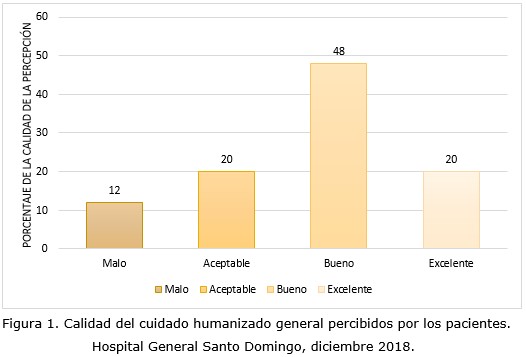Humanized nursing care for patients with diabetic foot at the General Hospital Santo Domingo- Ecuador
Keywords:
calidad, percepción, cuidado humanizado, pie diabéticoAbstract
Background: human care is the basis of nursing, for this reason it must be viewed holistically. Patients with diabetic foot with or without treatment acquire damages such as amputations and emotional disturbances such as depression, so the nurse must look at the patient in a bio-psychosocial way, contributing to the improvement of their health, providing security to both the patient and to the institution, making him feel safe and leading him to have good adherence to treatment.
Objective: to determine the quality of humanized care from the perception of patients diagnosed with diabetic foot.
Methods: a descriptive cross-sectional design study was carried out with a quantitative approach applying a deductive method in the Comprehensive Care Unit for Diabetic Foot of the General Hospital Santo Domingo- Ecuador, with a population of 50 patients who wished to participate and signed informed consent for the respective sample. The instrument of the 3rd version PCHE questionnaire consisting of 32 questions was applied, which was adapted according to the study variables.
Results: the quality of humanized care based on the perception of patients with diabetic foot is positive in 92-94% consider that there is adequate communication between the patient nurse, but there is still a deficit of certain characteristics for the care to be human in its entirety.
Conclusions: the patient’s humanized care by the nursing staff is positive regarding its services, however, there is still a deficit of certain characteristics for the care to be human in its entirety.
DeCS: NURSING CARE; DIABETIC FOOT/nursing; DIABETIC FOOT/diagnosis; TREATMENT ADHERENCE AND COMPLIANCE; EPIDEMIOLOGY, DESCRIPTIVE.
Downloads
References
1. Busch I, Moretti F, Travaini G, Wu A, Ramondini M. Humanization of Care: Key Elements Identified by Patients, Caregivers, and Healthcare Providers. A Systematic Review. Patient [Internet]. 2019 [citado 22 Oct 2020];12(5):461-474. Disponible en: https://link.springer.com/article/10.1007/s40271-019-00370-1
2. Hernández J, De Maya B, Diaz A, Giménez M. Fundamentos teóricos de enfermería. 3ra ed. Murcia, España: DM; 2012.
3. Echevarría H. Percepción del paciente sobre calidad del cuidado humanizado brindado por la enfermera en una clínica-Lima. Cuid Salud [Internet]. 2017 [citado 22 Oct 2020];3(1):239-248. Disponible en: http://revistas.urp.edu.pe/index.php/Cuidado_y_salud/article/view/1421/1316
4. Pereira MC, Cárdenas MH. Visión fisiológica del cuidado humano en la mujer en la etapa del climaterio. Enfermería (Montevideo) [Internet]. 2019 [citado 18 Jun 2019];8(1):34-45. Disponible en: http://www.scielo.edu.uy/scielo.php?script=sci_arttext&pid=S2393-66062019000100022
5. Ramos S, Ceballos P. Cuidado humanizado y riesgos psicosociales: una relación percibida por profesionales de enfermería en Chile. Enfermería (Montevideo) [Internet]. 2018 [citado 22 Oct 2020];7(1):3-16. Disponible en: http://www.scielo.edu.uy/scielo.php?script=sci_arttext&pid=S2393-66062018000100003&lng=es
6. Bautista L, Parra E, Arias K, Parada K, Ascanio K, Villamarin M, et al. Percepción de los comportamientos de cuidado humanizado en los usuarios hospitalizados en una institución de salud de 3o y 4o nivel de atención. Rev Cienc Cuidad [Internet]. 2015 [citado 22 Oct 2020];12(1):105-118. Disponible en: https://dialnet.unirioja.es/servlet/articulo?codigo=5243988
7. Medvetzky L, Poggio L. Prevención y cuidados del pie en personas con diabetes [Internet]. Buenos Aires-Argentina: Ministerio de salud y desarrollo social; 2017 [citado 22 Oct 2020]:[aprox. 58 p.]. Disponible en: http://salud.jujuy.gob.ar/wp-content/uploads/sites/14/2019/12/MANUAL_Prevenci%C3%B3n-y-cuidados-del-pie-en-personas-con-diabetes.pdf
8. Toledo A, Vega L, Vega K, Ramos N, Zerpa C, Aparicio D, et al. Pie diabético de la fisiopatología clínica. Diabetes Int Endocrinol [Internet]. 2009 [citado 22 Oct 2020];3(1):63-67. Disponible en: https://www.researchgate.net/publication/245445116_Pie_Diabetico_de_la_Fisiopatologia_a_la_clinica
9. Guerrero R, Meneses M, De la Cruz M. Cuidado humanizado de enfermería según la teoría de Jean Watson. Ocronos [Internet]. 2020 [citado 22 Oct 2020];3(2):125. Disponible en: https://revistamedica.com/cuidado-humanizado-enfermeria-cirugia-hospital-general-isidro-ayora/.
10. Rodríguez A. Cuidado humanizado que brinda la enfermera en emergencia [tesis]. Trujillo-Perú: Universidad Privada Antenor Orrego; 2016 [citado 22 Oct 2020]:[aprox. 39 p.]. Disponible en: http://repositorio.upch.edu.pe/bitstream/handle/upch/3532/Cuidado_AndamayoQuito_Maria.pdf?sequence=1&isAllowed=y#:~:text=Para%20el%20abordaje%20de%20este,rescatar%20siempre%20la%20dignidad%20el
11. Organización Mundial de la Salud. Enfermería [Internet]. 2018 [citado 22 Oct 2020]. Disponible en: http://www.who.int/topics/nursing/es/.
12. Sociedad Ecuatoriana de pie diabético. Pie diabético [Internet]. Guayaquil-Ecuador: SEPID; 2017 [citado 22 Oct 2020]. Disponible en: http://sepid-ec.com/wp-content/uploads/2016/10/GPC-PIE-DIABETICO-2016-2017.pdf
13. Antunéz M, Bettiol A. Depresión en pacientes con diabetes tipo 2 que acuden a una consulta externa de medicina interna. Acta Med Colomb [Internet]. 2016 [citado 22 Oct 2020];41(2):102-110. Disponible en: http://www.scielo.org.co/scielo.php?script=sci_abstract&pid=S0120-24482016000200102&lng=en&nrm=iso&tlng=es
14. Beltrán Salazar O. Atención al detalle, un requisito para el cuidado humanizado. Index Enferm [Internet]. 2015 [citado 22 Oct 2020];24(1-2):49-53. Disponible en: http://scielo.isciii.es/scielo.php?script=sci_arttext&pid=S1132-12962015000100011&lng=es
15. Beléndez Vázquez M, Lorente Armendáriz I, Maderuelo Labrador M. Estrés emocional y calidad de vida en personas con diabetes y sus familiares. Gac Sanit [Internet]. Ago 2015 [citado 22 Oct 2020];29(4):300-303. Disponible en: http://scielo.isciii.es/scielo.php?script=sci_arttext&pid=S0213-91112015000400011&lng=es
16. Tinoco M. Percepción del cuidado humanizado de enfermería por parte del paciente adulto con enfermedad oncológica hospitalizado en una IPS de IV nivel [tesis]. Colombia: Universidad de la Sabana, Chía; 2017 [citado 22 Oct 2020]. Disponible en: https://intellectum.unisabana.edu.co/bitstream/handle/10818/32533/Percepci%C3%B3n%20del%20cuidado%20humanizado%20de%20enfermer%C3%ADa%20por%20parte%20del%20paciente%20adulto%20con%20enfermedad%20oncol%C3%B3gica%20hospitalizado%20en%20una%20ips%20de%20iv%20nive.pdf?sequence=1&isAllowed=y
17. González Hernández OJ. Validez y confiabilidad del instrumento Percepción de comportamientos de cuidado humanizado de enfermería PCHE 3ª versión. Aquichan [Internet]. 2015 [citado 22 Oct 2020];15(3):381-392. Disponible en: http://www.scielo.org.co/scielo.php?script=sci_arttext&pid=S1657-59972015000300006&lng=en
18. Hernández R, Fernández C, Baptista P. Metodología de la investigación. 6a ed. México: McGraw-Hill; 2010.
19. Monje P, Miranda P, Oyarzún J, Seguel F, Flores E. Perception of humanized nursing care by hospitalized users. Ciencia Enferm [Internet]. 2018 Sep [citado 22 Oct 2020]; 24(5). Disponible en: http://www.scielo.org.co/scielo.php?script=sci_arttext&pid=S1657-59972015000300006&lng=en
20. Riding S, Glendening N, Heaslip V. Real world challenges in delivering person-centred care: A community-based case study. Br J Community Nurs [Internet]. 2017 [citado 22 Oct 2020];22(8):391-396. Disponible en: https://www.magonlinelibrary.com/doi/abs/10.12968/bjcn.2017.22.8.391?rfr_dat=cr_pub++0pubmed&url_ver=Z39.88-2003&rfr_id=ori%3Arid%3Acrossref.org
21. Condori C, Colque N, Abrahan J. Percepción del paciente y familiares sobre el comportamiento del cuidado de humanizado de enfermería. Área de observación emergencia HRHDE [tesis]. Perú: Universidad Nacional de San Agustín de Arequipa, Arequipa; 2018 [citado 22 Oct 2020]. Disponible en: http://repositorio.unsa.edu.pe/handle/UNSA/7829

Published
How to Cite
Issue
Section
License
Copyright: Camagüey Medical Archive Magazine, offers immediately after being indexed in the SciELO Project; Open access to the full text of the articles under the principle of making available and free the research to promote the exchange of global knowledge and contribute to a greater extension, publication, evaluation and extensive use of the articles that can be used without purpose As long as reference is made to the primary source.
Conflicts of interest: authors must declare in a mandatory manner the presence or not of conflicts of interest in relation to the investigation presented.
(Download Statement of potential conflicts of interest)
The Revista Archivo Médico de Camagüey is under a License Creative Commons Attribution-Noncommercial-No Derivative Works 4.0 International (CC BY 4.0).
This license allows others to distribute, to mix, to adjust and to build from its work, even for commercial purposes, as long as it is recognized the authorship of the original creation. This is the most helpful license offered. Recommended for maximum dissemination and use of licensed materials. The full license can be found at: https://creativecommons.org/licenses/












 22 julio 2025
22 julio 2025